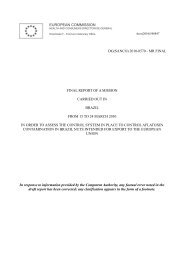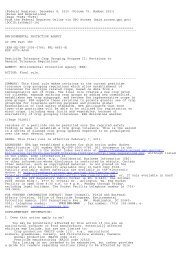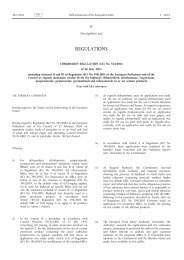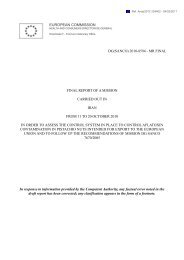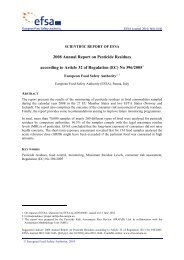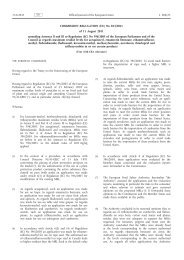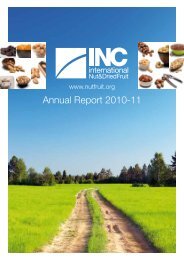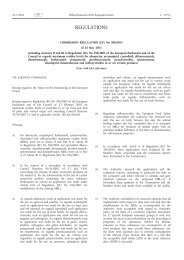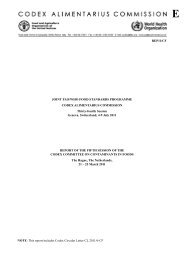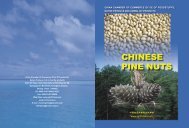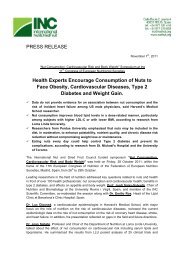REP11/PR JOINT FAO/WHO FOOD STANDARDS PROGRAMME ...
REP11/PR JOINT FAO/WHO FOOD STANDARDS PROGRAMME ...
REP11/PR JOINT FAO/WHO FOOD STANDARDS PROGRAMME ...
You also want an ePaper? Increase the reach of your titles
YUMPU automatically turns print PDFs into web optimized ePapers that Google loves.
<strong>REP11</strong>/<strong>PR</strong> Appendix X 102<br />
The relative expanded MU, U′ (at 95% confidence level) may then be estimated by<br />
U′ = 2u'.<br />
Since the Horwitz equation is a function of analyte concentration, it will provide a range of MU values depending on pesticide<br />
concentration as noted in the following table:<br />
Concentration (mg/kg) u′(%) U′ (%)<br />
1.0 16 32<br />
0.1 22.6 45<br />
0.01 32 64<br />
Example 1.<br />
A laboratory measures 0.40 mg/kg chlorpyrifos in a sample of tomato.<br />
The Horwitz Equation predicts a relative reproducibility standard deviation of 18.4% at a concentration of 0.40 mg/kg.<br />
u′ = 18.4 %<br />
U′ = 2u′ = 37%<br />
The laboratory would therefore report the result as 0.40 ± 0.15 mg/kg<br />
The laboratory report should state that the reported uncertainty was an expanded uncertainty with a coverage factor of 2 to give a<br />
level of confidence of approximately 95%. Unless stated otherwise, this is generally assumed for results reported with expanded<br />
uncertainties.<br />
In the absence of supporting data, the Horwitz equation should be used with some caution and only as an indicator of the likely<br />
uncertainty associated with test results. Advances in analytical methodologies, particularly instrumental techniques, have provided<br />
the capability to achieve very low limits of quantitation with much less uncertainty then predicted by the Horwitz Equation. Thompson<br />
and Lowthian [3] have reported that laboratories tend to out-perform the Horwitz function at low concentrations. It should be noted<br />
however that the Thompson concept limits the maximum value for u′ for concentrations below 0.1 mg/kg to 22% independent of the<br />
concentration.<br />
5.2 Estimating MU by application of the EU default value of 50%<br />
Before applying a default MU, laboratories should ensure that they are able to routinely achieve uncertainties not greater than the<br />
default value.<br />
Example 2:<br />
A laboratory measures 0.40 mg/kg chlorpyrifos in a sample of tomatoes. An agreed default value of ± 50% is to be applied to the<br />
measured result.<br />
Accordingly, the laboratory would report the result as 0.40 ± 0.20 mg/kg.<br />
5.3 Estimating MU based on Intra-laboratory QC and data from PT Studies<br />
5.3.1 Using the assigned (or consensus) value from PT studies<br />
Equation 1<br />
U′ = 2u′<br />
u' =<br />
2<br />
2<br />
u'(Rw) + u'(bias)<br />
Equation 2<br />
where U′ = expanded relative uncertainty<br />
Example 3:<br />
u′ = combined relative standard uncertainty<br />
u′(Rw) = relative standard uncertainty due to within-laboratory imprecision (relative intra-laboratory<br />
reproducibility standard deviation)<br />
u′(bias) = relative standard uncertainty component due to bias<br />
In this example, u′(Rw) is obtained from within-laboratory QC data, preferably long-term QC data and u′(bias) is estimated from PT<br />
data.



